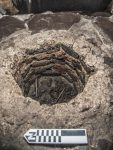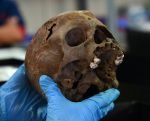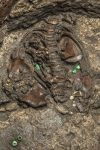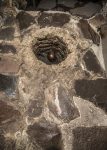 Archaeologists from Mexico’s National Institute of Anthropology and History (INAH) have unearthed the remains of a child sacrificed by the Aztecs at the foot of the Templo Mayor in the center of Mexico City. This is the second child burial found at the Templo Mayor. The first was discovered in 2005.
Archaeologists from Mexico’s National Institute of Anthropology and History (INAH) have unearthed the remains of a child sacrificed by the Aztecs at the foot of the Templo Mayor in the center of Mexico City. This is the second child burial found at the Templo Mayor. The first was discovered in 2005.
The child was a boy between eight and 10 years of age at the time of his death. INAH experts believe he was sacrificed to the god of war Huitzilopochtli sometime around the late 15th century during the reign of emperor Ahuízotl (1486-1502). Osteological examination by physical anthropologist Jacqueline Castro found that his teeth were heavily worn and he had suffered from multiple infections in his mouth.
anthropologist Jacqueline Castro found that his teeth were heavily worn and he had suffered from multiple infections in his mouth.
His body was adorned with a ring-shaped wooden breastplate called an anahuatl, a mark associated with Huitzilopochtli as well as a few other deities. He also wore two rectangular wooden ear decorations, a pyrite piece and a necklace with five green stone beads thought to be  Guatemalan jadeite and some blue beads made of an unknown stone. He had copper bells, shells from the Caribbean Sea and green stone beads on his ankles. The discovery of bones from two bird wings is another indicator that he was offered to Huitzilopochtli because a previous child sacrifice found at the site included the wings of a forest hawk, an animal linked to the war god due to its ocher and blue coloring.
Guatemalan jadeite and some blue beads made of an unknown stone. He had copper bells, shells from the Caribbean Sea and green stone beads on his ankles. The discovery of bones from two bird wings is another indicator that he was offered to Huitzilopochtli because a previous child sacrifice found at the site included the wings of a forest hawk, an animal linked to the war god due to its ocher and blue coloring.
The excavation that revealed this burial was spurred by the discovery of a gravestone bearing the relief of a golden eagle that predates the child’s death by decades. The tombstone is from the reign of Moctezuma I (1440-1469), so was not related to the sacrifice. It was just a coincidence that so significant an artifact was found that the team explored the area further and found the remains of the child.
 The location of the burial, dubbed Offering 176, at the foot of the steps of the sixth stage of the Templo Mayor built during the reign of Ahuízotl is highly significant. It is within the Cuauhxicalco, a circular building which Spanish chroniclers recorded was the site where the remains of Mexica rulers were deposited. Perhaps in connection with its location, the tomb itself is unusual in shape and construction. The pit is cylindrical, lined with volcanic rocks mortared together with stucco. Of the 204 tombs discovered at the Templo Mayor, this is the only one with these particular features. Building the tomb required raising stone slabs, filling the square with soil and building another stone square on top of it.
The location of the burial, dubbed Offering 176, at the foot of the steps of the sixth stage of the Templo Mayor built during the reign of Ahuízotl is highly significant. It is within the Cuauhxicalco, a circular building which Spanish chroniclers recorded was the site where the remains of Mexica rulers were deposited. Perhaps in connection with its location, the tomb itself is unusual in shape and construction. The pit is cylindrical, lined with volcanic rocks mortared together with stucco. Of the 204 tombs discovered at the Templo Mayor, this is the only one with these particular features. Building the tomb required raising stone slabs, filling the square with soil and building another stone square on top of it.
The remains of the child sacrifice found in 2005, Offering 111, showed evidence of his heart having been removed during the ceremony. Whether this child too suffered the same fate is not known at this time.